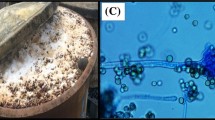Abstract
Ethanol tolerance is a key trait of microbes in bioethanol production. Previous studies have shown that soya flour contributed to the increase of ethanol tolerance of yeast cells. In this paper, the mechanism of this ethanol tolerance improvement was investigated in cassava ethanol fermentation supplemented with soya flour or defatted soya flour, respectively. Experiment results showed that ethanol tolerance of cells from soya flour supplemented medium increased by 4–6% (v/v) than the control with defatted soya flour. Microscopic observation found that soya flour can retain the cell shape while dramatic elongations of cells were observed with the defatted soya flour supplemented medium. Unsaturated fatty acids (UFAs) compositions of cell membrane were analyzed and the UFAs amounts increased significantly in all tested strains grown in soya flour supplemented medium. Growth study also showed that soya flour stimulated the cell growth rate by approximately tenfolds at 72-h fermentation. All these results suggested that soya fatty acids play an important role to protect yeast cells from ethanol stress during fermentation process.

Similar content being viewed by others
References
Sasson, A. (1990). Feeding tomorrow’s world. pp. 500–510. Paris: UNESCO.
Jaleel, S. A., Srikanta, S., Ghildyal, N. P., & Lonsane, B. K. (1988). Starch (Starke), 40, 55–58. doi:10.1002/star.19880400205.
Ueda, S., Zenin, C. T., Monteiro, D. A., & Park, Y. K. (1981). Biotechnology and Bioengineering, 23, 291–299. doi:10.1002/bit.260230205.
Ghareib, M., Youssef, K. A., & Khalil, A. A. (1988). Folia Microbiologica, 33, 447–452. doi:10.1007/BF02925769.
Sajbidor, J. (1997). Critical Reviews in Biotechnology, 17, 87–103. doi:10.3109/07388559709146608.
Sajbidor, J., Ciesarova, Z., & Smogrovicova, D. (1995). Folia Microbiologica, 40, 508–510. doi:10.1007/BF02814733.
Mishra, P., & Prasad, R. (1989). Applied Microbiology and Biotechnology, 30, 294–298. doi:10.1007/BF00256221.
Beaven, M. J., Charpentier, C., & Rose, A. H. (1982). Journal of General Microbiology, 128, 1447–1455.
Thomas, K. C., Hynes, S. H., & Ingledew, W. M. (1994). Applied and Environmental Microbiology, 60, 1519–1524.
Bajpai, P., Sharma, A., Raghuram, N., & Bajpai, P. K. (1988). Biotechnology Letters, 10, 217–220. doi:10.1007/BF01134833.
Li, X. (1995). Biotechnology Letters, 17, 327–330. doi:10.1007/BF01190647.
Schibeci, A., Rattray, J. B. M., & Kidby, D. K. (1973). Biochimica et Biophysica Acta, 311, 15–25. doi:10.1016/0005-2736(73)90250-2.
Castrillo, J. I., & Ugalde, U. O. (1993). Applied Microbiology and Biotechnology, 40, 386–393. doi:10.1007/BF00170398.
Dubois, M., Gilles, K. A., Hamilton, J. K., Rebers, P. A., & Smith, F. (1956). Analytical Chemistry, 8, 350–366. doi:10.1021/ac60111a017.
Viegas, C. A., Sá-Correia, I., & Novais, J. M. (1985). Applied and Environmental Microbiology, 50, 1333–1335.
Akamatsu, Y. (1974). Journal of Biochemistry, 76, 553–561.
Acknowledgements
This work was mainly supported by the National High Technology Research and Development Program of China (the “863” Program; Grant No. 2006AA020101) and the Key Science and Technique Foundation, Tianjin city of China (Grant No. 06YFGZSH00500).
Author information
Authors and Affiliations
Corresponding author
Rights and permissions
About this article
Cite this article
Xiao, D., Wu, S., Zhu, X. et al. Effects of Soya Fatty Acids on Cassava Ethanol Fermentation. Appl Biochem Biotechnol 160, 410–420 (2010). https://doi.org/10.1007/s12010-008-8344-7
Received:
Accepted:
Published:
Issue Date:
DOI: https://doi.org/10.1007/s12010-008-8344-7




